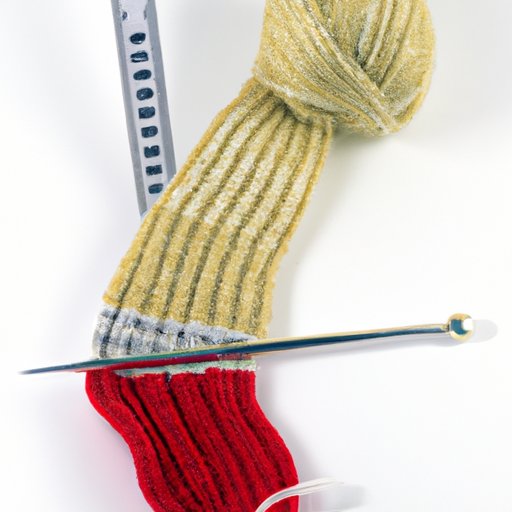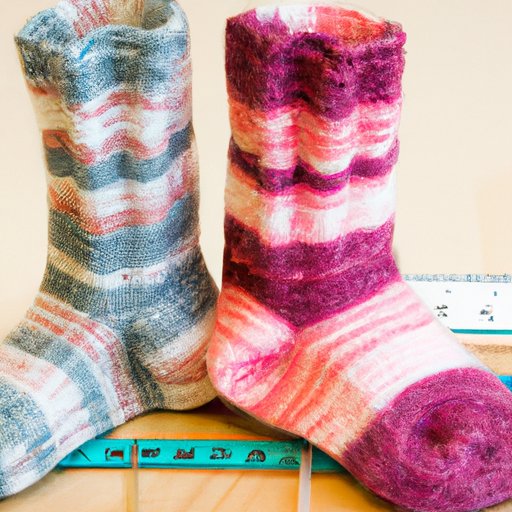
Introduction
When it comes to knitting or crocheting socks, choosing the right weight of yarn can make all the difference in the final product. Sock yarn weight is an important aspect to consider, as it determines everything from the size and fit of the sock to the durability and comfort. In this comprehensive guide, we’ll explore the various aspects of sock yarn weight and provide you with expert tips and advice to help you choose the perfect weight for your sock project.
Understanding Sock Yarn Weights: A Comprehensive Guide
Socks are typically knitted or crocheted using specialty yarn known as sock yarn. Sock yarn is different from regular yarn in that it is specifically designed to create socks that are comfortable, snug-fitting, and long-lasting. It is typically lightweight, durable, and has properties such as being moisture-wicking and anti-microbial.
The weight of sock yarn plays a crucial role in determining the final outcome of the project. The weight of the yarn will dictate the size and fit of the sock, as well as how warm or cool the finished product will be. The weight will also determine the amount of yarn needed to complete the project and the recommended needle or hook size.
There are various weights of sock yarn available, ranging from lace weight to bulky weight, and each offers its own unique set of characteristics and properties.
Deciphering the Weight of Sock Yarn: Commonly Used Standards
There are several systems used to categorize yarn weight, and sock yarn is no exception. The most commonly used standards for sock yarn weight include fingering weight, sport weight, and worsted weight.
Fingering weight yarn is the most popular weight for sock knitting and is also known as sock weight yarn. It is a lightweight yarn that is typically plied to increase durability. It has a recommended gauge of 7 to 8 stitches per inch and a recommended needle size of US 1 to 3.
Sport weight yarn is slightly heavier than fingering weight yarn and has a recommended gauge of 6 stitches per inch. It has a recommended needle size of US 3 to 5.
Worsted weight yarn is the heaviest of the three and has a recommended gauge of 4 to 5 stitches per inch. It has a recommended needle size of US 6 to 9. Although not typically used for sock knitting, it can produce warm and cozy socks.
It is important to note that these weights may vary depending on the manufacturer, and it is always best to check the yarn label for the recommended gauge and needle or hook size.
Countries also differ in their yarn weight standards, with some using terms such as 2-ply, 3-ply, or 4-ply to indicate yarn thickness. The United States uses the Craft Yarn Council standard to categorize yarn weight while the United Kingdom uses the ply system.
Sock Yarn Weights Explained: Choosing the Right Weight for Your Project
Choosing the appropriate sock yarn weight for your project is crucial in achieving the desired outcome. It is important to consider various factors such as the pattern, intended use of the finished product, and the natural properties of the yarn.
For patterns that require a tight stitch, such as cables or colourwork, a lighter weight yarn such as fingering or sport weight may help define the stitches better. On the other hand, for patterns that require a looser stitch, such as lace, a heavier weight yarn such as worsted weight may be more suitable.
In terms of the intended use of the finished product, sock yarns made of natural fibers such as wool, alpaca, or mohair offer excellent insulation and are best suited for cold weather. Synthetic fibers such as nylon or polyester offer excellent durability and moisture-wicking properties and are suitable for socks that will see regular use.
Each sock yarn weight has its own set of pros and cons. Fingering weight yarns are lightweight and produce fine and delicate stitches, making them great for intricate patterns. However, they can be more time-consuming to work with due to the smaller needle or hook size. Worst weight yarns produce warm and cozy socks but can be too thick to allow for good stitch definition. Sport weight yarns strike a balance between the two and are a good choice for those looking for a light yet durable sock.

The Science Behind Sock Yarn Weight: How It Affects the Final Product
The weight of sock yarn affects the final product in several ways. The weight will determine the drape of the sock, or how it conforms to the shape of the foot. Heavier weight yarns generally result in a less drapey sock, while lighter weight yarns produce a sock with excellent drape.
The weight of the yarn also affects stitch definition. Heavier weight yarns are better suited for simpler stitch patterns, while lighter weight yarns are better for intricate stitch patterns that require good stitch definition.
Finally, the weight of the yarn affects the durability of the sock. Heavier weight yarns are generally more durable and are better suited for socks that will see regular use.
Comparing Sock Yarn Weights: Which One Works Best for Your Pattern?
When choosing the appropriate sock yarn weight for a specific pattern, it is important to consider various factors such as gauge, yardage, fiber content, and the type of stitch pattern.
Fingering weight yarn is the most versatile and can be used for a wide array of patterns. If using a pattern that requires a heavier weight yarn, it is important to find a suitable substitute that has a similar gauge and yardage.
It is also important to consider the fiber content of the yarn. Natural fibers such as wool or alpaca are best suited for cold weather while synthetic fibers such as nylon or polyester offer excellent durability and are suitable for socks that will see regular use.
When in doubt, it is always best to make a gauge swatch to ensure that the chosen yarn weight is suitable for the pattern and to prevent any sizing issues.
Sock Yarn Weight Chart: A Simplified Guide for Knitters and Crocheters
To simplify the process of choosing the appropriate sock yarn weight, a chart outlining the different sock yarn weights, recommended needle/hook sizes, and gauge can be useful.
Fingering Weight:
– Gauge: 7-8 stitches per inch
– Recommended needle size: US 1-3
Sport Weight:
– Gauge: 6 stitches per inch
– Recommended needle size: US 3-5
Worsted Weight:
– Gauge: 4-5 stitches per inch
– Recommended needle size: US 6-9
Expert Tips on Selecting the Perfect Weight for Your Sock Yarn Project
Experts advise selecting a sock yarn weight based on the desired outcome of the finished product. For socks that require good stitch definition and drape, lighter weight yarns such as fingering or sport weight are recommended. For durability, heavier weight yarns such as worsted weight are best suited.
To troubleshoot common issues related to sock yarn weight, it is recommended to make gauge swatches and adjust needle or hook size as necessary. It is also advisable to use high-quality yarn to ensure the finished product is both durable and comfortable.
Conclusion
In conclusion, selecting the appropriate sock yarn weight is crucial in achieving the desired outcome of the final product. Understanding the various weights and standards of sock yarn can help make the selection process easier. By considering factors such as gauge, yardage, and fiber content, knitters and crocheters alike can be confident in their choice of sock yarn weight and can create comfortable, stylish, and long-lasting socks. Remember to experiment with different yarn weights to find the one that works best for your project, and don’t be afraid to ask experts for advice along the way.





